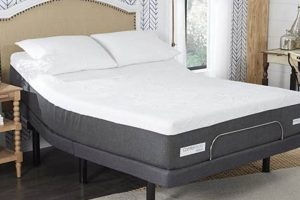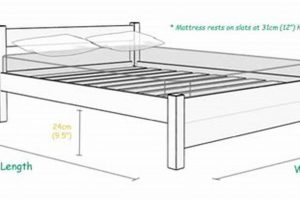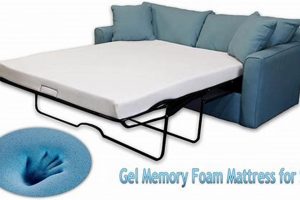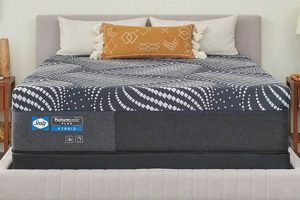A versatile piece of furniture, this item serves a dual purpose, functioning primarily as a seating solution while also providing a sleep surface when needed. It typically consists of a supporting frame, cushioning materials for comfort, and a folding mechanism that allows for easy transformation between the two configurations. Construction materials can vary, ranging from metal and wood for the frame to foam, innerspring, or a combination for the sleeping surface.
The appeal of this type of furniture lies in its space-saving design, making it particularly suitable for smaller living areas, guest rooms, or multi-purpose spaces. Its utility extends beyond residential settings, finding applications in offices, dormitories, and even recreational vehicles. Historically, variations of convertible furniture have existed for centuries, but modern designs prioritize both comfort and ease of use, reflecting evolving consumer needs and manufacturing capabilities.
Considering factors such as material composition, size dimensions, folding mechanism, and intended use is essential when evaluating options within this furniture category. Understanding the various features and functionalities contributes to making an informed purchasing decision that aligns with specific spatial and comfort requirements. The following sections will delve into these critical aspects in greater detail.
Considerations for Selecting a Convertible Sofa Bed
The purchase of a convertible sofa bed requires careful assessment to ensure long-term satisfaction and utility. Several factors warrant consideration to optimize the investment.
Tip 1: Evaluate Space Constraints: Measure the available space in both sofa and bed configurations. Account for surrounding furniture and potential obstructions to ensure unimpeded operation and movement.
Tip 2: Prioritize Sleeping Surface Comfort: Assess the mattress type, thickness, and density. Consider individual sleep preferences (firmness, support) to minimize discomfort and ensure adequate rest. Reading reviews and checking specifications on mattress types is a must.
Tip 3: Examine Frame Construction: Inspect the frame materials (wood, metal) for durability and stability. A robust frame ensures longevity and prevents premature wear or breakage. Look at how it is constructed, its weight capacity and what it is supposed to be holding.
Tip 4: Assess Folding Mechanism Functionality: Test the folding and unfolding mechanism for ease of use and smooth operation. A cumbersome mechanism can detract from the convenience and usability of the furniture.
Tip 5: Scrutinize Upholstery Fabric: Select upholstery that is durable, stain-resistant, and easy to clean. Consider the fabric’s aesthetic appeal and its compatibility with the existing dcor of the room.
Tip 6: Determine Intended Frequency of Use: For frequent use as a bed, prioritize higher-quality mattresses and robust frame construction. Infrequent use may warrant prioritizing aesthetic appeal and space-saving design over ultimate comfort.
Tip 7: Research Weight Capacity: Ensure that the selected model has an adequate weight capacity. Make sure it is strong enough to support it’s intended users.
Careful consideration of these elements enhances the likelihood of selecting a convertible sofa bed that meets individual needs and expectations. Neglecting these factors may lead to dissatisfaction and premature replacement.
The subsequent sections will provide detailed information regarding the specific types of convertible sofa beds and their respective advantages and disadvantages.
1. Material Composition
Material composition is a foundational aspect of any foldable sofa bed mattress, directly influencing its comfort, support, durability, and overall suitability for its intended purpose. The selection of materials dictates the sleeping experience and the product’s ability to withstand repeated folding and unfolding.
- Foam Density and Type
Foam is a common component, with varying densities and types (polyurethane, memory foam, latex) impacting firmness, support, and heat retention. High-density foam offers superior support and durability, while memory foam contours to the body, enhancing comfort. Lower density foams are more susceptible to sagging and compression over time. In the context of a foldable sofa bed mattress, the foam’s resilience is paramount, enabling it to recover its shape after being folded and unfolded repeatedly.
- Innerspring Coils
Innerspring mattresses feature coils that provide support and bounce. The gauge and configuration of the coils influence firmness and motion transfer. Thicker coils offer more support, while individually wrapped coils minimize disturbance from a partner’s movements. The use of innerspring in a foldable design presents challenges in terms of flexibility and potential for coil damage, necessitating careful engineering to ensure durability.
- Fiber Fillings
Fiber fillings, such as polyester or cotton batting, are often used to provide a soft surface layer over the core support materials. These fillings contribute to the initial comfort but can compress over time, reducing the mattress’s overall support. The type and amount of fiber filling can significantly impact the overall feel of the mattress. They are good for breathability. They are also good for fire safety regulations.
- Cover Fabric
The cover fabric plays a role in comfort, breathability, and durability. Materials like cotton, polyester blends, or specialized performance fabrics can affect the mattress’s surface temperature, moisture wicking ability, and resistance to wear and tear. The cover must be flexible enough to accommodate the folding mechanism without tearing or bunching. Zippers and secure stitching are vital to ensuring it does not rip or get damaged.
The interplay of these materials determines the overall performance of a foldable sofa bed mattress. For instance, a high-density foam core combined with a breathable cover fabric can provide a balance of support, comfort, and durability, while a low-quality innerspring with thin fiber fillings may offer inadequate support and a short lifespan. Selecting materials appropriate for the intended use and frequency of folding is essential for maximizing the product’s value.
2. Foldable Design
Foldable design is a core characteristic defining the functional utility of a convertible sofa bed. It dictates the ease and efficiency with which the furniture transitions between its seating and sleeping configurations, directly impacting user convenience and space optimization.
- Bi-Fold Mechanism
The bi-fold mechanism involves folding the mattress in half, similar to closing a book. This de
sign typically results in a more compact sofa configuration but may limit the maximum length of the sleeping surface. The simplicity of the bi-fold design can enhance its durability, but it may also result in a firmer seating surface due to the doubled mattress layers. - Tri-Fold Mechanism
The tri-fold mechanism segments the mattress into three sections, allowing for a more streamlined sofa appearance and potentially a longer sleeping surface when unfolded. This design often incorporates a leg support system that unfolds along with the mattress to provide stability. The increased complexity of the tri-fold mechanism may necessitate more robust construction to ensure long-term reliability.
- Click-Clack Mechanism
The “click-clack” mechanism involves reclining the backrest of the sofa to create a flat sleeping surface. This design is characterized by its simplicity and ease of operation, often requiring minimal effort to switch between configurations. While convenient, click-clack mechanisms may offer a less consistent sleeping surface compared to dedicated foldable mattresses, as the backrest section may differ in firmness or support.
- Frame Integration
The foldable design’s success hinges on the frame’s ability to seamlessly accommodate the folding and unfolding action. A well-designed frame provides necessary support and ensures the mattress sections align correctly in both sofa and bed configurations. Frame materials, hinge quality, and locking mechanisms are critical components that determine the overall stability and longevity of the convertible sofa bed.
Each of these foldable design elements contributes to the overall user experience. The choice of mechanism influences the ease of conversion, the comfort of both the sofa and bed configurations, and the long-term durability of the furniture. Understanding these design aspects is crucial for selecting a foldable sofa bed that meets individual needs and spatial constraints.
3. Thickness & Density
The characteristics of thickness and density within a foldable sofa bed mattress are paramount in determining its comfort, support, and long-term performance. These properties directly influence the sleeping experience and the durability of the product, particularly given the stresses associated with repeated folding and unfolding.
- Support and Pressure Distribution
The thickness of a mattress contributes to its ability to support the user’s weight and distribute pressure evenly. Insufficient thickness can result in bottoming out, leading to discomfort and potential back pain. Density, particularly in foam mattresses, influences the degree of support and the mattress’s ability to conform to the body’s contours. Higher density foams generally provide more support and better pressure relief than lower density alternatives. In the context of a foldable sofa bed, adequate thickness and density are crucial to compensate for the segmented nature of the mattress, minimizing pressure points and ensuring a relatively uniform sleeping surface.
- Durability and Sag Resistance
Density plays a pivotal role in the mattress’s ability to resist sagging and maintain its shape over time. High-density materials are less prone to compression and deformation, extending the mattress’s lifespan. In a foldable design, the stresses of repeated folding and unfolding can accelerate wear and tear, making density a particularly important consideration. Mattresses with insufficient density are more likely to develop indentations and lose their supportiveness, compromising comfort and potentially leading to premature replacement.
- Thermal Properties and Breathability
Thickness and density also influence the mattress’s thermal properties and breathability. Thicker mattresses, particularly those made with dense materials, can retain more heat, potentially leading to discomfort for sleepers who tend to overheat. However, the density of the materials also affects breathability. More open-cell foams, despite being dense, promote airflow and dissipate heat more effectively than closed-cell foams. In the context of foldable sofa beds, which may be used in confined spaces, selecting materials with good breathability is important for maintaining a comfortable sleeping temperature.
In summary, the interrelationship between thickness and density is a critical factor in evaluating the quality and suitability of a foldable sofa bed mattress. Prioritizing appropriate thickness and density levels ensures a comfortable, supportive, and durable sleep surface that can withstand the demands of a convertible design. These factors must be carefully considered in relation to intended use, user weight, and individual comfort preferences.
4. Size Dimensions
The size dimensions of a foldable sofa bed mattress are critical considerations, directly affecting its suitability for specific spaces, the comfort level provided in both sofa and bed configurations, and its ease of use. Accurate assessment of these dimensions is essential for informed purchasing decisions and optimal utilization.
- Sofa Configuration Footprint
The dimensions of the sofa when folded dictate its spatial requirements in a living area. Length, width, and height measurements determine its compatibility with existing furniture arrangements and traffic flow. Overly large dimensions may create congestion and impede movement, while insufficient dimensions may compromise seating capacity. Practical implications involve measuring the available space prior to purchase, accounting for clearances around doorways and other furniture items.
- Mattress Dimensions (Unfolded)
The unfolded mattress dimensions determine the sleeping area available. Length and width measurements dictate the suitability for different user heights and sleeping preferences. Standard mattress sizes (twin, full, queen, king) offer a benchmark for comparison, but variations exist in foldable sofa bed mattresses. Inadequate length can result in discomfort for taller individuals, while insufficient width may restrict movement during sleep.
- Thickness Considerations
Mattress thickness impacts both comfort and ease of folding. Excessive thickness may complicate the folding process and increase the sofa’s overall bulk, while insufficient thickness may compromise support and comfort. Thickness must be balanced with material density and construction to ensure adequate support without hindering the folding mechanism.
- Weight and Portability
While technically not a dimension, the weight of the unit, heavily influenced by its size and materials, affects portability and ease of movement. A heavier unit may be difficult to relocate or transport, while a lighter unit may be less stable or durable. Evaluating the weight in relation to intended use and frequency of relocation is essential.
These dimensional aspects are interconnected and collectively determine the practical utility of a foldable sofa bed mattress. Careful consideration of these factors, including measurement of the intended space and assessment of user needs, is essential for selecting a model that provides both comfortable seating and adequate sleeping arrangements.
5. Support Sy
stem
The support system within a foldable sofa bed mattress is a crucial element dictating its ergonomic performance, durability, and suitability for various sleeping preferences. Its design and materials directly influence spinal alignment, pressure distribution, and long-term resilience, all of which are paramount for a convertible piece of furniture subject to frequent use and folding.
- Foam Core Composition
The foam core serves as a primary support structure, offering varying degrees of firmness and contouring. High-density foams provide greater resistance to compression and maintain spinal alignment for a wider range of body weights. Memory foam conforms to the body’s shape, reducing pressure points. The specific blend and layering of foam types significantly influence the mattress’s overall support characteristics. For instance, a high-density polyurethane base topped with a layer of memory foam can provide both firm support and conforming comfort, which is essential for mitigating discomfort in mattresses subject to repeated folding.
- Innerspring Coil Configuration
Innerspring systems utilize interconnected or individually wrapped coils to provide support and resilience. Coil gauge (thickness) and coil count determine the firmness and responsiveness of the mattress. Individually pocketed coils minimize motion transfer, enhancing sleep quality for couples. However, the folding mechanism of sofa beds presents unique challenges for innerspring systems. Coils must be sufficiently flexible to withstand bending without losing their structural integrity or creating uneven support. Reinforcements and specialized coil configurations are often necessary to address these concerns.
- Reinforcement Structure
Given the segmented nature of foldable sofa bed mattresses, reinforcement structures play a critical role in maintaining consistent support across the sleeping surface. These structures can include metal frames, strategically placed foam inserts, or reinforced seams that connect the mattress sections. Their purpose is to prevent sagging, ensure proper alignment, and distribute weight evenly, particularly along the folding lines. Without adequate reinforcement, the mattress may develop uncomfortable pressure points or lose its shape over time.
- Platform Foundation
The foundation upon which the mattress rests significantly impacts its overall support performance. A solid, level platform provides a stable base, preventing uneven compression and maximizing the effectiveness of the mattress’s internal support system. Slatted platforms offer some degree of flexibility but require careful design to ensure adequate support and prevent sagging between the slats. The quality of the folding mechanism itself, including the hinges and locking mechanisms, also contributes to the overall stability and support of the convertible sofa bed.
The interplay between these support system facets directly influences the overall comfort and longevity of the foldable sofa bed mattress. A well-designed support system, incorporating appropriate materials and construction techniques, can effectively mitigate the challenges posed by the folding mechanism, providing a comfortable and supportive sleep surface that withstands frequent use. Conversely, a poorly designed support system will compromise both comfort and durability, resulting in a less satisfactory sleeping experience and a shorter product lifespan.
6. Portability
The characteristic of portability significantly influences the utility and adaptability of a foldable sofa bed mattress. Portability extends beyond the mere ability to move the item; it encompasses factors affecting the ease and practicality of relocation, thereby broadening its potential applications in various settings.
- Weight and Dimensions
The weight and dimensions of the folded unit are primary determinants of its portability. A lighter, more compact unit is inherently easier to transport, allowing for relocation within a residence or to a new location. Examples include moving the sofa bed between rooms, transporting it to a vacation home, or storing it when not in use. A heavy, bulky unit, conversely, restricts movement and may require specialized equipment or assistance.
- Integrated Handling Features
The presence of integrated handles, wheels, or carrying cases enhances the portability of a foldable sofa bed mattress. Handles provide a secure grip for lifting and maneuvering, while wheels facilitate rolling movement across smooth surfaces. Carrying cases protect the unit during transport and further consolidate its form. The absence of such features necessitates manual lifting and carrying, increasing the physical burden and risk of damage.
- Disassembly and Reassembly
The ability to easily disassemble and reassemble the foldable sofa bed mattress contributes to its portability. Models that can be broken down into smaller components are easier to transport through narrow doorways or up staircases. Complex disassembly processes, however, negate the benefits of portability, rendering the unit impractical for frequent relocation.
- Storage Requirements During Transport
The space required to store the foldable sofa bed mattress during transport is a critical consideration. A unit that can be compressed into a small volume is more easily accommodated in vehicles or storage facilities. Bulky units may necessitate larger vehicles or dedicated storage spaces, increasing the logistical challenges and costs associated with relocation.
These elements collectively define the practicality of moving a foldable sofa bed mattress. The degree of portability directly impacts its versatility and adaptability to changing spatial needs. A highly portable unit offers greater flexibility for temporary accommodations, space-saving solutions, and multi-functional living arrangements, thus expanding its overall value proposition.
7. Storage
Storage considerations are intrinsically linked to the utility of a foldable sofa bed mattress, particularly in environments where space optimization is paramount. The ability to efficiently store the mattress, either separately or as part of the folded sofa unit, enhances its practicality and expands its potential applications.
- Dedicated Storage Compartments
Some convertible sofa beds incorporate dedicated storage compartments beneath the seating area or within the frame structure. These compartments provide convenient storage for bedding, pillows, or other accessories, minimizing clutter and maximizing space efficiency. The dimensions and accessibility of these compartments directly impact their usability. They allow user to store all the equipment after using the sofa bed
- Folded Dimensions for Separate Storage
When the mattress is intended for separate storage, the folded dimensions become critical. A mattress that folds into a compact form is easier to store in closets, attics, or under beds. The method of folding (bi-fold, tri-fold) and the materials used in construction influence the fina
l folded size. This separate storage provide space saving for user. - Protection During Storage
Proper storage practices are essential for preserving the condition of the foldable sofa bed mattress. Protecting the mattress from dust, moisture, and pests prevents damage and extends its lifespan. Storage bags, covers, or vacuum sealing can provide a barrier against environmental factors. The place of storage affect the mattress quality, so it need to protect from mosture and pests.
- Accessibility and Ease of Retrieval
The ease with which the mattress can be retrieved from storage is a significant factor in its usability. A conveniently located and easily accessible storage space encourages frequent use of the sofa bed function. Cumbersome storage arrangements, conversely, can deter users from converting the sofa into a bed. A convenient storage can affect the user mood.
In summary, the integration of thoughtful storage solutions enhances the overall appeal and functionality of a foldable sofa bed mattress. Whether through dedicated compartments, compact folding designs, or protective storage measures, these considerations contribute to a more user-friendly and space-efficient product, appealing to those seeking versatile furniture solutions.
Frequently Asked Questions
The following addresses common inquiries regarding the selection, use, and maintenance of foldable sofa bed mattresses. This information is intended to provide clarity and assist in making informed decisions.
Question 1: What mattress thickness is generally recommended for a foldable sofa bed mattress?
Thickness recommendations vary based on user weight and comfort preferences. However, a minimum thickness of 4 inches is generally advised to provide adequate support. Mattresses exceeding 6 inches may offer enhanced comfort but can impact the ease of folding and the overall size of the sofa.
Question 2: How often should a foldable sofa bed mattress be rotated or flipped?
Regular rotation and flipping (if applicable) can prolong the life of the mattress and prevent uneven wear. Rotation every 3-6 months is recommended. However, mattresses with a designated top and bottom should only be rotated.
Question 3: What type of cleaning products are safe to use on a foldable sofa bed mattress?
The cleaning products to be used depend on the mattress material. Mild detergents diluted in water are generally safe for spot cleaning. Harsh chemicals should be avoided as they can damage the fabric and internal materials. Always test cleaning solutions on an inconspicuous area first.
Question 4: How can the lifespan of a foldable sofa bed mattress be extended?
Several factors contribute to extending lifespan. Regularly cleaning the mattress, using a mattress protector, rotating the mattress, and ensuring the folding mechanism operates smoothly can all prolong its usability. Avoiding excessive weight or impact on the mattress is also recommended.
Question 5: Are there specific weight restrictions for foldable sofa bed mattresses?
Yes, most foldable sofa bed mattresses have specified weight limits. Exceeding these limits can damage the mattress and frame, voiding any warranty. Weight restrictions are typically indicated on the product label or in the accompanying documentation.
Question 6: Can a standard mattress topper be used on a foldable sofa bed mattress?
The use of a standard mattress topper is possible; however, it may affect the ease of folding and the overall fit within the sofa frame. Select a topper that is appropriately sized and flexible to minimize these issues.
These responses provide a general overview of common concerns. Specific recommendations may vary depending on the individual product and manufacturer guidelines. Consultation with the product documentation is always advisable.
The subsequent section will delve into best practices for the long-term maintenance and care of foldable sofa bed mattresses.
Conclusion
The preceding exploration has underscored the multifaceted nature of the foldable sofa bed mattress. Critical attributes, encompassing material composition, design intricacies, dimensional constraints, support mechanisms, portability considerations, and storage implications, collectively determine its suitability for diverse applications. A thorough assessment of these interconnected elements is paramount to ensure user satisfaction and long-term utility.
The selection process should prioritize a comprehensive understanding of individual needs and spatial limitations. Prudent evaluation, guided by the insights provided, will enable informed purchasing decisions, maximizing the potential of this versatile furniture category. Further research and adherence to manufacturer guidelines are encouraged to optimize both the performance and longevity of the chosen foldable sofa bed mattress.





![Best Queen Adjustable Bed & Mattress [Guide & Reviews] Organic & Natural Mattress Buyer’s Guide: Non-Toxic Sleep Solutions Best Queen Adjustable Bed & Mattress [Guide & Reviews] | Organic & Natural Mattress Buyer’s Guide: Non-Toxic Sleep Solutions](https://mattressworldpa.com/wp-content/uploads/2025/07/th-7128-300x200.jpg)

